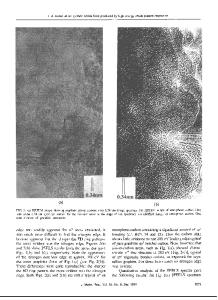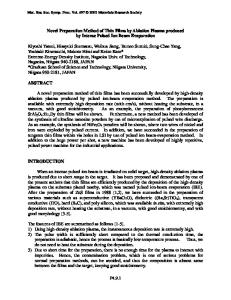Fluorinated Diamond-Like Carbon Films Produced by Plasma Immersion Ion Processing Technique
- PDF / 265,874 Bytes
- 6 Pages / 420.48 x 639 pts Page_size
- 41 Downloads / 436 Views
M. HAKOVIRTA, D. H. LEE, X. M. HE, M. NASTASI Los Alamos National Laboratory, Los Alamos, NM 87545
ABSTRACT Fluorinated diamond-like carbon (F-DLC) coatings were deposited on polished silicon substrates with plasma immersion ion processing (PIIP) technique. In the PIIP technique, pulsed glow discharge plasma from a mixture of acetylane and hexafluoroethane gases was used. Contact angle measurements were performed in order to see the un-wetting properties of the coatings. The film composition was measured with Rutherford Backscattering Spectroscopy (RBS) and Elastic Recoil Detection Analysis (ERDA) and the hardness was measured with a Nanoindenter® II. The results clearly show that the un-wetting properties and hardness are strongly dependent on the fluorine incorporation in the F-DLC coatings. With optimized gas ratio of acetylane and hexafluoroethane gases, a combination of extremely good un-wetting properties and high hardness was achieved. INTRODUCTION Diamond-like carbon films (DLC) are known to have such properties as high hardness, wear resistance and extremely low friction. Because of their attractive properties, many applications for DLC coatings have been developed or are still under development. The applications range from protective coatings for optical applications to coatings for improving the lifetime of medical implants [1-4]. A new application field for DLC coatings is in the un-wetting applications. A scratch resistant and extremely hard coatings with excellent hydrophobic properties are very attractive for industry and has many practical applications. The DLC is in itself only mildly hydrophobic by nature. Therefore, elements such as F, N, 0 or Si, have been succesfully incorporated into it by using a variety of different techniques [5]. The deposition of different types of fluorinated films can be performed by sputtering of polytetrafluoroethylene (PTFE) target or by using plasma-assisted deposition [6-7]. In case of the plasma deposition of F-DLC films, fluorocarbon-hydrocarbon mixtures have been mostly used [8-9]. It has been shown that the un-wetting properties of F-DLC films can reach the performance of PTFE and the hardness and wear resistance have been kept relatively high [1011]. In order to develop deposition technique for thin films used in applications, the technique must be easily scalable to a production scale. According to the literature, the plasma deposition techniques that have been used to produce hard F-DLC with good un-wetting properties have been line-of-sight processes. These techniques make it difficult to coat complex shaped objects uniformly. In this paper, the investigation for the use of the Plasma Immersion Ion Processing (PIIP) technique in the deposition of F-DLC coatings has been reported. The PUP process differs from the Plasma Source Ion Implantation (PSII) process by the fact that it employs a low pulsed285 Mat. Res. Soc. Symp. Proc. Vol. 593 © 2000 Materials Research Society
bias voltage, typically less than 10 kV, and enables the deposition of thin films on v
Data Loading...










